My second blog post on the Federation of Middlesex Beekeepers’ Associations annual ‘Bee Keepers’ Day‘, held last Saturday. Below are my notes from the second speaker, Dr Karin Alton. Karin is an entomologist from Sussex University, working with Professor Ratnieks at the Laboratory of Apiculture & Social Insects (LASI) on the hygienic bee project there. She explained to us that the hygienic behaviour shown by some honey bee workers includes:
1) Detecting dead or diseased larvae
2) Removing dead or diseased larvae
Through these types of behaviour, hygienic worker bees reduce the need for chemical anti-varroa treatments. There is a genetic basis for hygiene, with several recessive genes linked to increased hygienic behaviour. Around 10% of the general population of British honey bees have these genes. It is not something that bees can be taught or trained to do, either by other bees or humans – it’s all in their genetic coding.
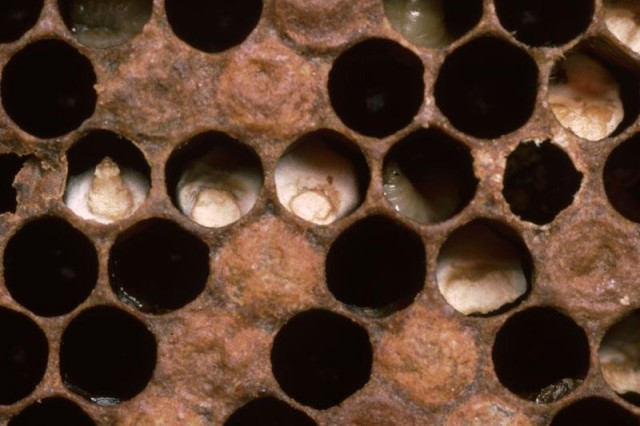
Chalk brood infection – hygienic workers should remove these larvae. Courtesy The Food and Environment Research Agency (Fera), Crown Copyright.
The Sussex team are trying to use dark, locally adapted bees for their hygienic research. They have been experimenting with killing off small areas of brood by pouring liquid nitrogen into circles of brood comb, using baked bean cans! Within 48 hours hygienic bees will clean out the circles of destroyed comb. So far the colonies studied have varied from between 20-90% of the dead brood having been removed after 48 hours, depending on how hygienic the bees were.
Breeding hygienic bees is obviously difficult because bees within colonies vary in hygienic behaviour, due to being half-sisters with a number of different fathers. Trying to breed for hygiene involves a continual process of testing and assessing bees. Artificially inseminating queens provides control over which drone sperm the queen receives, but, Karin commented, is “fiendishly difficult”! Inseminating a queen, even one knocked out with anaesthetic, requires a very steady hand. That we have no queen rearing industry in the UK adds to the difficulty, so the Sussex team is hoping to receive training from outside experts.
Practical difficulties of breeding hygienic bees
- The genetics of honey bees is still poorly understood
- Undesirable traits can pop up, such as aggressiveness
- Proper evaluation of “selected” characteristics can be difficult
- Need to avoid inbreeding
- Progress is slow and time consuming, with constant monitoring required
More details about the project are available on the University of Sussex website: Breeding disease-resistant ‘hygienic’ honey bees.
Changes in our landscape
Karin next turned to a different topic; the dramatic change in the UK’s landscape over recent decades and how this has affected the amount of forage available to bees. A few sobering facts:
- 50% of British hedgerows have been removed since WW2. The 1997 Hedgerows Regulations now aim to protect hedgerows – let’s hope they slow the pace of destruction.
- 97% of flower meadows have been lost since the 1940s – we now have less than 8,000 hectares left, mostly as small, isolated fields. Only half of these are protected as Sites of Special Scientific Interest (SSSI sites).
- After the ice age, wild woodland would have covered most of the UK. We are now one of the least wooded countries in Europe – only 12% wooded.
- Ancient woodland makes up only 2% of the UK’s land area.
- We are the 16th most road covered country in the world, yet only the 76th biggest country in the world.
- A 2012 RAC survey, Spaced Out: Perspectives on parking policy, suggested that around 1/3 of our front gardens have been paved over to be used as car parking spaces – a figure that will come as no surprise to most Londoners.
Given these figures, from my point of view it’s no surprise that many bee species are struggling. It’s more amazing that we have any bees left at all.
FlowerSCAPES
As well as her research work at Sussex Uni, Karin is also involved in running her pollinator-friendly wildlife gardening consultancy company FlowerSCAPES, along with her husband Steve Alton. Together they carry out planting advisory services, talks and training, as well as selling wild flower seed mixes.
They have found that councils, and the British people in general, are very reluctant to change their gardening habits. In many cities, bedding plants (mostly grown in Holland and shipped over) are changed three times a year, at a cost of approximately £60-65 per square metre per year. In addition to this expense, councils often mow public lawns in places such as parks around 15 times a year. West Sussex County Council pays £1m annually to cut its grass.
What level of emissions do you think an industrial lawnmower produces? If you think less than a car, you’re likely to be wrong. Take a look at these figures, tweeted below by Steve & Karin:
Ford Focus – 166g CO2per Km. Ride-on mower – 1992.9g CO2 per Km! Sow some FlowerScapes instead: goo.gl/2d7dZ
— Steve & Karin Alton (@FlowerScapes) February 25, 2013
Mowers, such as the Ransom Jackson Commander 3520 model, churn out CO2 at alarming rates. Unlike with cars, there are no regulations requiring British lawnmower manufacturers to either reduce or advertise their emissions.
We are currently in a situation where councils are so financially stretched that they are merging hospitals and cutting community services such as libraries. Is cutting grass really what our councils should be spending money on? Sowing Karin’s pollinator mixes only costs £5 per square metre annually, and meadows only need three cuts a year.
One council told Karin that they received a barrage of complaints from dog walkers about their dogs getting wet, after park grass was left to grow longer. My way of looking at that is that dogs are not about to go extinct, whereas several native bee species face that threat. What’s our priority as a society, protecting our native wildlife and spending our money on community services, or religiously trimming grass ultra-short so that we don’t have to towel-dry our dogs?
Karin finished her talk with a plea to us beekeepers to become ‘floral terrorists’, planting bee-friendly flowers wherever we go. Let’s ditch the dull roundabouts of imported bedding plants and go back to beautiful poppies waving in a summer breeze.

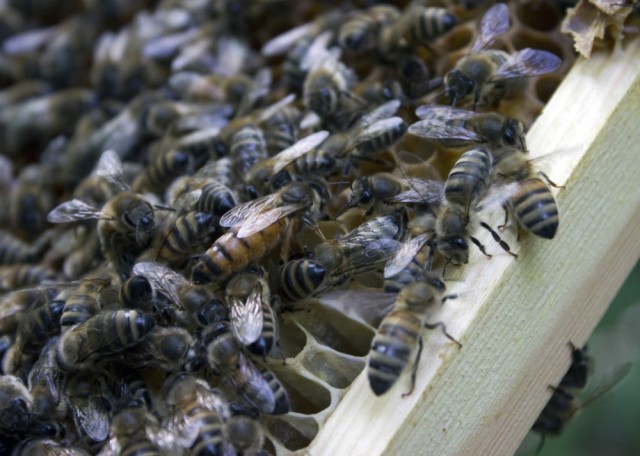
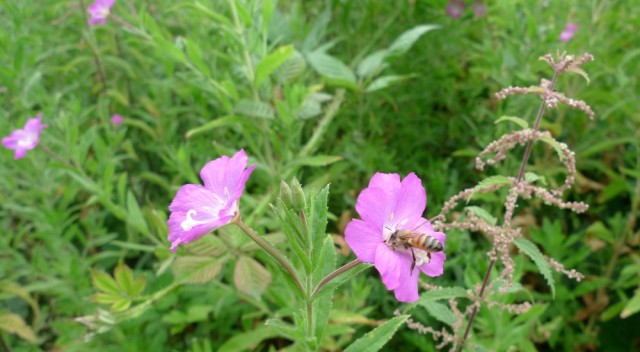
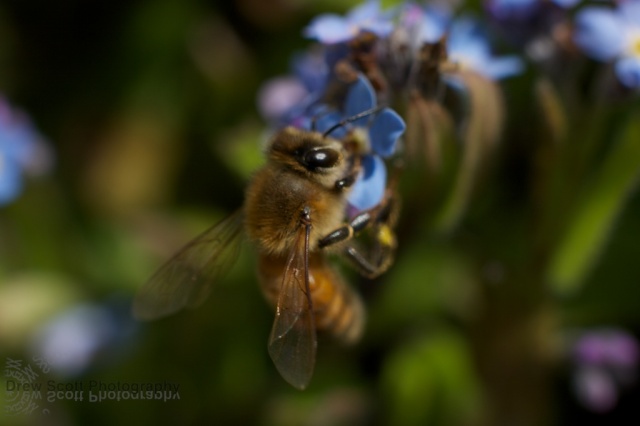
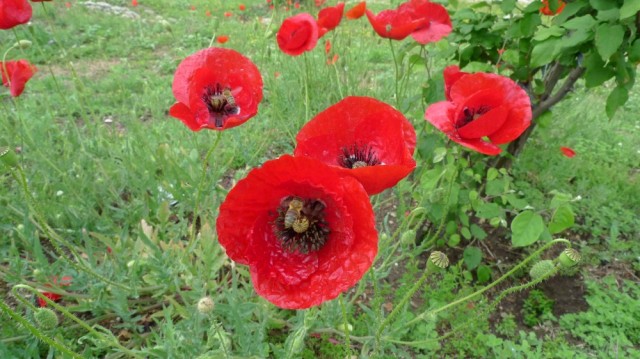
Another interesting post.
Is anyone talking about bee health being linked to diversity of diet? Do bees with a “better” diet (ie not sugar water or a single food source) fight off disease like chalk brood or varroa mite more readily?
I can’t help but wonder if putting bees on a single crop to pollinate it or moving them to a forest with only one source of food to produce a specific flavour of honey might somehow weaken a colony. They’ve evolved to collect food from a huge variety of sources yet we have limited that both by cutting out wild plants (as you discuss in this post) and by turning them into commercial pollinators then robbing their honey and feeding them sugar water.
LikeLike
Hi Laura, yes I have come across studies which demonstrated that diversity of foraging sources is important for bee health, especially when it comes to pollen. For instance, see http://rsbl.royalsocietypublishing.org/content/6/4/562.short. It’s probably an even bigger problem for bumble and solitary bees, as they tend to forage over shorter distances and aren’t being looked after by beekeepers. If they set up home near oil seed rape fields, what do they feed on when the rape’s not flowering?
LikeLike
Great article, thanks for the link. It confirms what my instincts have told me – polyfloral is better for bees than monofloral. Go diversity!
LikeLike
Very interesting. Sounds like the start of a campaign.
As you know I’ve had a high varroa count this year and hygenic bees sound like the way forward.
LikeLike
I think the research into these bees is really important. If you want to try out the hygienic queens, the downside is that they’re more costly and you have to keep buying in a new hygienic queen each time your old queen dies. But you might find it’s worth it to have healthier bees.
LikeLike
This is fascinating, Emily. There is clearly still some way to go in researching hygenic bees, but Sussex are learning so much. And the stats on our environment are depressing; there appears to be a need to “educate” local councils about having a bee-friendly approach.
LikeLike
Yes, if only councils were more willing to give new ideas a go… particularly as they would save a lot of money through Karin’s planting schemes.
LikeLike
Thanks for writing up my talk, Emily! best wishes, Karin.
LikeLike
Thanks Karin, I really enjoyed it 🙂
LikeLike
Dear blog owner,
Interesting post, but particularly the “hygienic worker bees” have nothing to do with chalk brood infection…
-It only depends on the queen as it’s a genetical problem! Change the queen and the chalk brood will disappear. 😉
LikeLike
Hi Tibor, thanks for your comment. My reason for including the photo of chalk brood larvae was that hygienic workers should remove these larvae, I wasn’t trying to imply that chalk brood infection is caused by the workers.
LikeLike
The part about mowing is quite an eye-opener, and something that tends to be invisible. People don’t think twice about the costs of mowing (labor, fuel, equipment, pollution) and actually come to view it as some sort of societal right. I wonder if some communities could engage local sheep farmers (or even hobbyists) to address mowing concerns in certain areas. It wouldn’t be the right solution for every situation, but every little bit counts. Thank you for helping to get the word out about the wide range of issues and concerns that affect bees. It’s nice to think there’s something each of us can do, even if it’s only to change some of the plants in our yards or gardens, to make a difference.
LikeLike
Sheep is a good idea! We have plenty of rabbits around to nibble the grass short too. It’s quite mad how much wasteful time and energy is put into importing expensive plants that are bad for our native pollinators, as well as polluting our atmosphere to produce grass deserts.
LikeLike
I bet if they had asked the dogs, they would have said they loved the long grass! And, an excuse not to mow? Yay!
LikeLike
Yes, long grass must be much more fun for a dog. Silly spoil-sport owners.
LikeLike
Such an interesting post, as usual. I was interested in the hygienic genes. I seems as if if they have only traced it to more than one recessive gene they are still have a good way to go. Do they do comparative DNA analysis on bees? It must be very hard to work from the phenotype with multiple sperm donors.
I do believe gardeners behaviour can be changed, mine has. I site ignorance as my excuse and blogs like yours help. I do think more people think of the bees and nature as something they can do something to help but pressure has to be maintained in the media as it is no good preaching to the converted. I try and spread my enthusiasm and explain my actions to everyone I meet. It is amazing how ignorant people in the country are about nature (well here they are). Every little helps 🙂
LikeLike
I’m not sure whether they do comparative DNA analysis. It sounds like you know much more about genetics than me! There’s more on the technical side of the research on the Uni of Sussex website at http://www.admin.susx.ac.uk/lasi/sussexplan/hygienicbees.
Lots of bee breeders abroad sell queens they describe as hygienic, but I wonder how accurate their claim to hygiene is, as there is no standard they have to meet in order to sell their queens as hygienic.
It’s brilliant what you are doing with your garden, I love seeing your photos of all the creatures you share your space with.
LikeLike
I’m retired but my work involved DNA sequencing. From the link they are using DNA markers so it looks like they know what genes they are targeting. It is a fascinating study. If they were able to breed hygienic bees it would be so good if it lead to control of varroa.
LikeLike
I see, that makes me feel better that I didn’t fully understand your first comment! Will let you know if I hear anything further about the research as it progresses.
LikeLike
Would be great to start a network of floral terrorists going.
LikeLike
Yep, throwing seeds onto all the barren bits of soil, taking over all the little spaces…the best kind of terrorism!
LikeLike
I don’t feel so bad for missing the talks now that you’ve written them up here! Great post! 🙂
LikeLike
Thanks. I still have another post that I haven’t written up yet, but probably won’t get round to that for a while!
LikeLike
Pingback: Types of Honey | Laura Rittenhouse's Gardening Journal